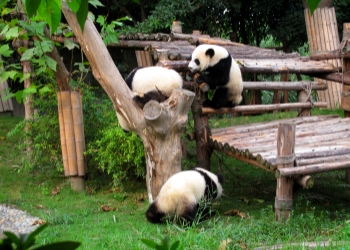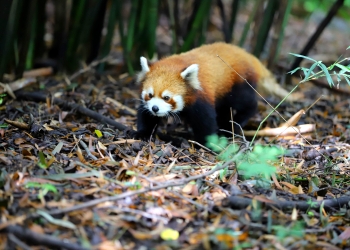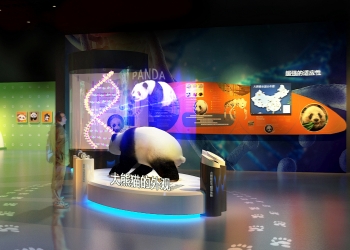The Chengdu Research Base of Giant Panda Breeding is a world-renowned relocation conservation base, scientific research and breeding base, public education base, and educational tourism base for giant pandas. Covering an area of 1,000 acres, it is renowned for its efforts in protecting and breeding giant pandas, red pandas, and other endangered wild animals unique to China as part of the "Ecological Demonstration Project for the Relocation and Protection of Giant Pandas." In 2006, the Chengdu Research Base of Giant Panda Breeding was rated as a national AAAA-level tourist attraction.
The Chengdu Research Base of Giant Panda Breeding was established based on the breeding, treatment, and conservation of giant pandas at the Chengdu Zoo. The base utilizes landscaping techniques to simulate the wild ecological environment of giant pandas, with orderly arrangements for giant panda birthing houses, panda feeding areas, research centers, and panda hospitals. Several luxurious "villas" for pandas are scattered among the mountains and forests. The expansion area fully follows and utilizes the original topography, creating a multi-level landscape belt of mountain streams and gullies. Based on the theme of pandas, the project is divided into several regions. By the end of 2020, the number of giant pandas in the population reached 215, making it the largest captive breeding population of giant pandas in the world.
What to See at Panda Base
Giant Panda

The Panda Base is renowned as the ultimate tourist destination for an intimate encounter with the rare giant panda. Here, you can observe the giant pandas of various ages in their natural habitats, whether they're lazily resting, avidly eating and drinking, playfully interacting with each other, engaging with enrichment toys, or watch in awe as female pandas tenderly nurse their cubs in the nursery rooms. Each moment spent with them is a treasured experience.
Baby Panda
From July to September, the panda babies grace the world with their arrival, and at the Sunshine Nursery House and Moonlight Nursery House, you can witness a heartwarming sight. Tens of ultra-adorable pink pandas, barely larger than the palm of your hand, lie in a row, each one a bundle of joy and innocence. This is a truly magical time to visit and experience the wonders of nature.

Other Species to See:
Amidst the serene and charming abode of the Giant Panda, lies a tapestry of other endangered wildlife, each adding a unique touch to this wondrous panda base. Alongside the serene giants, one can find graceful swans gliding gracefully across the lakes, their elegant necks curved in perfect symmetry. Colorful peacocks strut their feathers, displaying a vivid array of hues. Moreover, the panda base is also a haven for butterflies, and beneath the soil and leaves, hundreds of insects buzz and crawl.
Thus, a visit to the panda base is not just a chance to witness the rare and charming Giant Panda, but also an opportunity to immerse oneself in the rich biodiversity of this remarkable sanctuary.
Giant Panda Museum

The Giant Panda Museum boasts an exhibition area of 880 square meters, encompassing several sections focused on the giant panda's distribution, historical records, life mysteries, scientific research, conservation efforts, and future conservation plans. Three relatively independent yet interconnected exhibition halls have been constructed: the Giant Panda Hall, the Butterfly Hall, and the Vertebrate Hall. Additionally, the museum features comprehensive supporting service facilities spanning nearly 4,000 square meters, making it a comprehensive museum centered on showcasing human understanding, research, protection, and rescue efforts towards the giant panda.
Best Time to Visit
The optimal time to see giant pandas in a day is in the morning. It is recommended to arrive at the Panda Base before 9:00 am, as the pandas are typically fed between 9:00 and 11:00. Giant pandas are not afraid of cold weather, but they cannot tolerate extreme heat. Therefore, if the weather is too hot, they tend to stay indoors. Although summer may not be the best time to observe giant pandas outdoors, it is a good season, especially in July and September, to catch a glimpse of baby pandas in the panda nursery.
Travel Tips
Address: No.1375 Panda Avenue, Northern Suburb, Chenghua District, Chengdu City, Sichuan Province, China
Recommended Visiting Time: 2 ~ 3 hours
Open Hours: 07:30 ~ 18:00
Ticket Price: CNY 58
Sightseeing Car:
The entire base spans an expansive area of 67 hectares, requiring over three hours to traverse on foot. To cater to tourists, the base offers a sightseeing battery car service, which significantly reduces the duration of the tour to approximately one to two hours. (Fee: CNY10)
Notice:
Please observe the following guidelines when visiting the panda base to ensure the comfort and well-being of the giant pandas:
Avoid shouting. Your raised voice may disturb the pandas, disturbing their peaceful environment.
When taking photos of the pandas, refrain from using the flash, especially when photographing baby pandas. Their eyes are particularly sensitive to bright lights and could be harmed.
Do not feed the pandas with your own food. Your food may not be suitable for their diet, and it could upset their delicate digestive systems.
Do not pick bamboo from the base to feed the pandas. The staff provides a daily ration of food for them, ensuring they receive a balanced and nutritious diet.




































